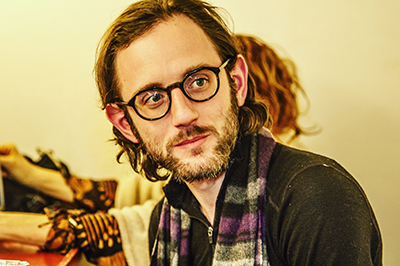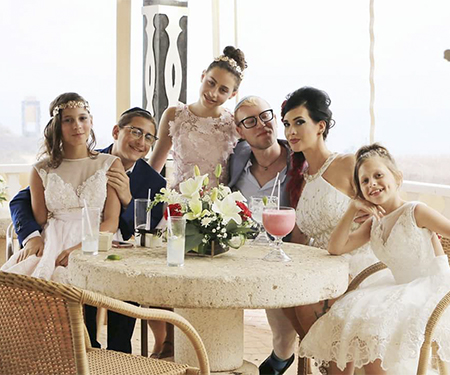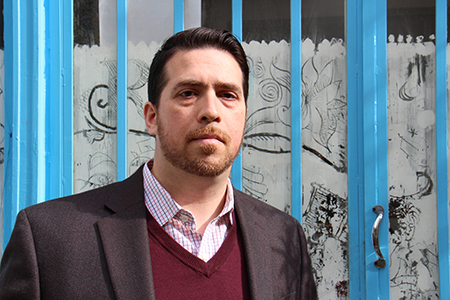American View
Life + Style
An Unorthodox Journey

When Pearl Perri Reich walks into the upscale Asbury Park, N.J., eatery near her home where we’ve arranged to meet and orders the ricotta polenta with meatballs, it takes me a minute to square the real-life appearance of the woman sitting across from me with the online persona I’ve been following curiously on Facebook for the last couple of years.
The main difference is now she’s wearing clothes.
On Facebook, Reich’s pictures leave little to the imagination: Here, she is naked except for some body paint, fluffy angel wings and high heels, embracing another almost-nude woman. There, Reich lies supine in an open blouse, exposing her black lace bra while clutching a book on female modesty written by an Orthodox rabbi, part of the title a Hebrew quote from Proverbs: “Her clothes are strength and dignity.”
The book offers a hint to Reich’s multilayered identity. She’s not just a body artist and jewelry designer who talks about sensuality as a path to spirituality. Reich, 35 and mother of four, is also an ex-Lubavitch Hasid from Brooklyn, N.Y.
She spends her days working and cavorting with models, strippers and artists. But she also keeps a kosher home—a stipulation of the shared custody arrangement for her four children who shuttle between Reich and her still-Hasidic ex-husband. She peppers her speech with Yiddish phrases and marks all the major Jewish holidays—though not necessarily in the traditional ways.
“My family thinks I’m crazy,” said Reich, who recently took her sister to see Waitress, her sister’s first Broadway show. “She asked me, ‘What’s your belief system?’ I said: ‘I have no system. I have no anchor. That’s why I can fly.’ ”
Reich is one of a growing number of Hasidim who have left the ultra-Orthodox fold, each forging his or her own path into the great unknown. Though Reich’s enthusiasm for public nudity is unusual for an ex-Hasid—for anyone, really—the challenges she experienced along her journey out of Hasidism are typical of those known in Orthodox circles as OTD, those who go “off the derech,” or path.
It’s not an easy journey. Parents and siblings may turn against them and ex-spouses fight for sole custody of the kids. Often raised in cloistered, Yiddish-speaking enclaves, they frequently find themselves ill-equipped for life in the wider world: Their English may be substandard, they have little secular education and few marketable skills. It may take years before they stop feeling caught between the ultra-Orthodox world they rejected anda secular world in which they feel out of place.
“I was ostracized,” said Luzer Twersky, 31, an ex-Belz Hasid from Brooklyn. “My parents didn’t speak to me for, like, seven years, and some of my siblings I still don’t speak to.”

Most difficult of all, he said, was the uncertainty of how to lead a new life. “It’s like being an immigrant from a place that is sheltered, like North Korea,” said Twersky, who left his community in 2007. “Everything is confusing. Why is that guy wearing a blue suit and that guy wearing something else? They’re speaking a foreign language, they’re going to jobs I’ve never heard of, they’re eating foods I’ve never seen.”
Now a successful actor with a role on the HBO show High Maintenance, Twersky notes that the majority of Hasidim who leave eventually find their place and lead successful lives. In that sense, Reich, whom he has met several times, is not unusual, he noted. She just happens to be very public about her life.
“The difficulties in the first years of leaving are immense, of course, but after a period the road gets a little straighter and smoother,” said Shulem Deen, 42, who has written a memoir about leaving the Skver Hasidic sect titled All Who Go Do Not Return. “What OTD folks often go through is the challenge of recognizing that the secular world is not monolithic, and that finding your place involves finding your specific community, your kindred spirits, your fellow travelers.”
It’s not uncommon for ex-Hasidim to struggle with depression. For some, it can be too much to bear. In July 2015, a 30-year-old former Belz Hasid named Faigy Mayer jumped to the street from a Manhattan rooftop bar, killing herself.
A week before her suicide, Mayer sent a friend an email screed castigating the Hasidic lifestyle: “If people were allowed to think, they would not be religious,” she wrote. “Thinking analytically when it comes to basic life decisions is something new to me and something I still struggle with, five years after leaving.”
Five months after her suicide, Mayer’s younger sister, Sarah Mayer, hanged herself in the family’s home in the Borough Park section of Brooklyn.
“Faigy was an amazing human being,” said Reich, who knew Mayer. “She did not die of mental illness. It was the result of her family and
her experience.”
Reich faced her own set of challenges when she left the Hasidic world. She had little money. Her youngest child was just 4 months old. Reich’s ex-husband was fighting her for sole custody of the kids. Onetime friends condemned her, spreading rumors that she was a sex addict.

“They were frightened of me leaving and going free,” Reich said. “My mother said, ‘You’ll never find someone to take you with your four kids.’ ”
But Reich was determined to make it, and to hold onto her children in the process.
Born in Israel but raised in Brooklyn since age 9, Reich had a less cloistered upbringing than most Hasidic women. Lubavitch is the most open of the Hasidic sects, and her father was involved in Jewish outreach work. As a result, Reich had opportunities to interact with nonreligious people as well as non-Jews and pursue studies outside the ultra-Orthodox world.
However, in other ways, Reich was following the same path as many Hasidim. She married at 18 and had four children in rapid succession.
But things were not going well. Her husband, she relates, was emotionally abusive. Though she believed in God and the Torah—“I had emunah p’shuta,” she said, Hebrew for blind faith—she felt that certain parts of her brain were dormant.
Most of all, she was overwhelmed. She was nursing babies, holding down a teaching job, running a household and supporting her husband, who spent his days studying in yeshiva.
Reich wanted out of the marriage before she wanted to quit ultra-Orthodoxy. As soon as she split from her husband, at the age of 24, she became an outcast. The rumors began, and schools were told not to hire her.
Stunned and embittered, Reich’s love for Hasidism began to crumble. That’s when she met Shauli Grossman, an ex-Hasid who is now her husband. A native of a Hasidic enclave in Monsey, N.Y., Grossman, 29, grew up as a Belzer, prayed two doors down from his home at the Vizhnitz shul and studied in the Sanz yeshiva in Brooklyn.
“I grew up with all these flavors—different extreme versions of the same bullshit,” Grossman said. He long had wanted out of Orthodoxy but struggled with giving up the belief system. Eventually he became a “hard-core atheist,” and the rest of his life followed suit.
When Grossman met Reich in 2011, “she had been dragged through the mud for a couple of years,” he said, “but she didn’t want to leave religion—yet.” The two had long talks about God and science.
Grossman took Reich to the American Museum of Natural History in New York and showed her the Hall of Human Origins, which traces human evolution using fossils and genetic data.
“I couldn’t believe it,” Reich said between puffs, turning to Grossman, who joined us after dinner at a smoky cigar bar. “It took four days of talking to you for me not to believe in God.”
After she lost her faith, Reich tried to develop a modeling career to make ends meet. She soon discovered body art. When artist Andy Golub began staging an annual event featuring the painted bodies of naked women outside the New York Public Library in midtown Manhattan, Reich lent her body as one of his canvases.
“It’s about spreading love and unity,” Reich said. “There were people of all different sizes and all different genders there.”
Soon Reich began organizing her own photo shoots and events. She appeared in a reality television show about ex-Orthodox Jews called Shunned and went on Dr. Phil with Rabbi Shmuley Boteach, author of Kosher Sex. She also started her own jewelry line, PearlPerri Jewelry & Accessories.
And in 2012, after eight years of fighting, she won the battle for joint custody of her children

Many who leave their Hasidic communities don’t get that outcome. Last year, a Hasidic community in London launched a public drive to raise $1.3 million to fund custody battles by divorced community members against ex-spouses who had left ultra-Orthodoxy. Similar efforts are common in New York.
Deen, the ex-Hasidic memoirist, has five children and was married for 15 years before he left that world. After his 2007 divorce, his visits with his children were restricted, and eventually tapered off. By the time his second daughter got married last year, Deen hadn’t seen his two elder daughters in years.
Though he wasn’t invited, Deen crashed the wedding. He stayed outside the hall so as not to cause a disruption, and someone told his daughters he was there. His eldest was the first to come out to greet him, along with a son-in-law he had never met before. It took Deen a moment to recognize his daughter.
“What do you say to a beloved child you haven’t seen and spoken to in eight years, whose entire adolescence you were barred from, whose wedding you missed?” Deen wrote in an emotional Facebook post the next day. “What came out of my mouth was, ‘I’ve missed you.’ I felt my insides crack. Last time we spoke she was 13, angry and sullen. Now she was 21, beautiful and grown
and smiling.”
He barely had a few seconds with her. An onlooker started screaming at his daughter for speaking with Deen. She ran off. Deen’s second daughter, the bride, came to see him, too. His other children did not.
Even during her custody battles, Reich was never cut off from her children. “Many women leave a marriage and they fall apart,” Reich said. “My thing is: I am a mother. I am a domestic engineer. I don’t go one day without my kids.”
Reich herself has not left religion completely behind. She retains elements of Jewish tradition that she feels are positive. On Shabbat, she takes a time out from technology, because she thinks it’s healthy for her family. She has a mezuzah on every doorway of her home.
Reich’s children—ages 15, 14, 12 and 10—each navigate the gap between their mother and Lubavitch father differently. They go to ultra-Orthodox yeshivas and, when with their father, dress and act in accordance with Lubavitch rules. At their mother’s house, they dress however they wish. Her son prefers strictly religious styles of dress, but her three daughters favor less modest, typical teenage garb. One of her daughters discreetly uses her phone on Shabbat.
“Kids can see and sense the truth,” Reich said. “You can look religious on the outside, but it’s the inside that counts—how you treat others.”
As for the future, Reich feels it is up to her children to decide what kind of lifestyle they prefer. “My home is a multicultural, multidimensional, open-ended, loving home that doesn’t have borders. We only have a moral compass based on love, kindness and integrity,” she said. “The rest is their choice.”
A Guide For The Perplexed
For Hasidim who choose to leave their community, nothing can be harder than struggling with the sense of being lost, many say. That’s where Footsteps comes in.
A Manhattan-based organization founded to help those on their journey out of ultra-Orthodoxy, Footsteps provides critical services like legal support and health and wellness as well as a community of like-minded people.
It’s impossible to say exactly how many Hasidim leave the fold. Footsteps’ organizers say it has served 1,300 members in the
New York area since it opened in 2003, and they estimate that at least 10,000 people are potentially in need of their services.
That is still just a small slice of the ultra-Orthodox community, the fastest-growing segment of the roughly 5.3 million Jews in America, according to a 2013 Pew Research Center survey. One in 10 American Jews are Orthodox, and 62 percent of those are ultra-Orthodox, a significant percentage of whom are part of a Hasidic sect. At the same time, the ultra-Orthodox birthrate is more than triple that of American Jews generally. The Pew survey also found that the Orthodox retention rate in America is higher today than in past generations.
“The Hasidic lifestyle may not work for every person born into a Hasidic community, but it does seem to for the vast majority of Hasidim,” said Rabbi Avi Shafran, director of public affairs of Agudath Israel of America, an ultra-Orthodox umbrella organization. “That majority treasures not only the family warmth and communal connections that are part and parcel of observant Jewish life, but also the deep connection to the Jewish past that pulses through the community’s daily life and rituals.”
Footsteps encompasses everyone from those thinking about leaving, to ex-Hasidim who have found their place in the secular world, to supporters who help members get GEDs and career training.
“Our community-engagement programs connect members to each other so they have allies in their journey, and to reduce feelings of isolation,” said Tsivia Finman, director of operations and planning at Footsteps.
A survey the organization conducted in 2015 found that what members need most is help with overall socializing, dating, relationships and employment—in that order.
Luzer Twersky, a former Belz Hasid who is now a film and television actor, said Footsteps deserves 90 percent of the credit for helping set him up for success in his new life. “Having that social support,” he said, “knowing you’re not going though it alone, is so important.”
Uriel Heilman is a journalist who works for the Jewish Telegraphic Agency in New York.










 Facebook
Facebook Instagram
Instagram Twitter
Twitter
Sara says
All of the innacuracies detract from your message. For example, pearl Reich was never a lubavitcher and neither is her ex husband.
Get your facts straight before publishing.
Anne Wilner says
This woman is a misrepresentation of young Married ultra Orthodox women. I can tell you. I have 2 married sons, who have been blessed with the most devout, modest wives and mothers. They are educated, intelligent, creative and absolutely beautiful to look at. Their choice is to be examples for their children. They are completely unselfish. They are not Hedonists. There is something greater than themselves. Do not blame this Religion for why this woman opted out of an Observant way of life. She thinks she’s Free. Let’s see what happens to her and her daughters in a couple of years.
Anne Wilner says
I fully agree with my friend, Shoshana. Hadassah needs to extol the virtues of those young women who go against the tide of today’s freaks who are tattooed all over their bodies. We just saw an example of great bravery and courage by a young orthodox mother who by her instincts to protect her five children, saved them from a savage Terrorist. Her last thoughts were regarding partying and body parts. Hadassah, do a better job and find more appropriate examples!
Malky says
Anna Wilner, YOU ARE SO SMART!!! I WAS THINKING ABOUT AT AS WELL….
and as you said: “Let’s see what happens to her and her daughters in a couple of years.” so true!!! She is really poor woman:(
Harry says
She has Mezuzas because she wants to keep part of religion??? BS!! She’s probably scared to death without them. Probably not even allowed to have a mezuzah on a Bais Zoina. She better ask Rabbi Phil…
Ben Black says
Not a nice article at all. You are better than this.
Kim sutton says
Being religious is 1 thing. Her choice . But it’s people like this…that no doubt choose to do things, “act out”, “rebel”….just because “they can”. I have no problem with these people making their own choices…about religion or anything else. But when there are children involved you need to think how you’re choices will effect them. Being a parent of young children and publicizing your “unconventional lifestyle”, nude and explicit pictures all over the Internet is just disgusting. Religious or not. It’s disgusting.
jason stern says
let her do what the hell she wants
joy says
you go Pearl. Great article and very inspiring.
emes emes says
This story is so pathetic. But sex sells, so Pearl got alot of attention and media coverage. Her behavior has made me suspect she is bipolar. May be reason there were reports Pearl had been in mental hospitals. Who knows… clearly something wrong there. She is NOT in same category of Shulem Deen who made rational decisions. Sadly, he was in New Square, a sick cult that condones burning someone’s house if they don’t pray in the rebbe’s synagogue. Smart to leave, but unfortunate to throw out the baby with the bath water. EMES can be found in other communities. I suspect someone at UJA who both funds Footsteps and Hadassah, wanted this story and they chose Heilman, who agreed to write it so he can pay his own rent. Footsteps has the same old, same old, characters they keep trotting out. Too risky to shine a light on the gay characters who are running the place and make alot of the guys feel unwelcome and out of place.
Kathy says
You’re just proving their point you know.
Saul says
I Have personally known and experienced various orthodox communities and they do actually provide alternatives to walking around undressed with body paint or producing films to make a couple bucks and get a bit of attention. I also personally know the Reich family very well and the commentator that says that neither she nor her ex were Lubavitcher Hasidim is absolutely correct though i can understand that in these types of articles accurate facts just end up getting in the way. To commentator “emes emes”: all you seem to know about Skvere is some uncontrolled Zealots who burned someones home down, but what about the 99% of the community who are wonderful giving people. To those who are bitter about leaving the Hasidic community, the fact that your parents raised you to be a farm boy and you want to work on Wall Street, doesn’t give you any right to blame them. Grow up.
joe shmoe says
well spoken